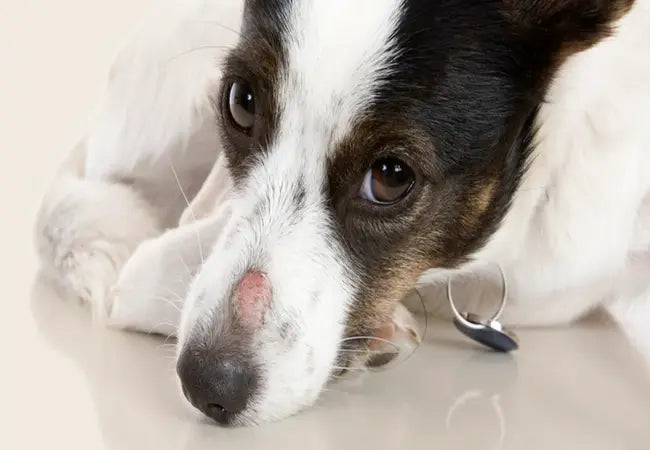Vet’s 2025 Guide to Dermatophytosis (Ringworm) in Dogs 🩺 Diagnosis, Treatment & Prevention

In this article
Vet’s 2025 Guide to Dermatophytosis (Ringworm) in Dogs 🩺 Diagnosis, Treatment & Prevention
By Dr. Duncan Houston BVSc
💡 What Is Dermatophytosis (Ringworm)?
Ringworm, medically known as dermatophytosis, is a fungal infection affecting the skin, hair, and sometimes nails of dogs. Caused by dermatophyte fungi—mainly Microsporum canis, Trichophyton mentagrophytes, and M. gypseum—it feeds on keratin and is highly contagious to other animals and humans.
🚩 Who Is Most At Risk?
- Puppies (<1 year)—immature immunity.
- Immune-compromised or senior dogs—chronic illness increases susceptibility.
- Exposure—contact with infected animals or contaminated environments.
🔍 Classic Signs & Symptoms
- Circular hairless patches—often scaly, crusty, and inflamed with raised edges.
- Patchy or diffuse lesions—may be pustular, kerion-like on inflamed skin.
- Nail involvement—brittle, discolored claws.
- Mild itch – dogs may lick or scratch lesions.
🧪 Diagnosing Ringworm in Dogs
- Wood’s lamp examination—green fluorescence in ~50% of M. canis cases.
- Microscopy—hair or scale samples in KOH reveal fungal hyphae.
- Fungal culture—gold standard, identifies species but takes 1–3 weeks.
- Dermatopathology—for atypical, inflammatory, or refractory lesions.
🩺 Treatment Strategies
1. Multimodal Approach
Effective treatment combines both systemic and topical therapy with environmental control.
2. Topical Therapy
- Dips twice weekly:
- Lime-sulfur dip – gold standard
- Enilconazole
- Miconazole + chlorhexidine shampoo.
- Creams/sprays—miconazole, clotrimazole, terbinafine applied 2× daily.
- Clipping affected areas—reduces fungal load; avoid nicking the skin.
3. Systemic Antifungal Therapy
- Itraconazole: highly effective, well-tolerated.
- Terbinafine: excellent skin penetration, lower cost.
- Griseofulvin: older, more side effects, still effective.
- Fluconazole/ketoconazole: alternatives but less preferred.
- Duration: minimum 6 weeks, continued until 2 negative cultures >1 week apart.
4. Environmental Control
- Vacuum and steam clean thoroughly.
- Disinfect hard surfaces with 1:10 bleach.
- Wash bedding, toys weekly in hot water/bleach.
- Isolate infected pets until two negative cultures.
📈 Prognosis & Monitoring
- Outcome: excellent with early, consistent treatment.
- Refractory cases: immunosuppressed dogs require longer therapy.
- Follow-up: exams and repeat cultures every 2–4 weeks.
- Short term: hair regrowth may lag behind fungal cure—continue therapy until testing confirms clearance.
🚫 Zoonotic Risks & Prevention
- Transmission to children and immunocompromised adults is possible.
- Wear gloves, wash hands after pet contact, avoid sharing bedding.
- Human lesions: ring-like rash; treat with over-the-counter antifungal creams.
🏡 Ask A Vet Home Support
- 📸 Upload lesion photos for vet review.
- 🕒 Schedule reminders for dips, topical meds, and bathing.
- 📊 Track lesion size, hair regrowth, and side effects.
- 🔔 Alerts for worsening, new lesions, or human infections.
- 📚 Tutorials: dip technique, home disinfection, safe isolation.
🔑 Key Takeaways
- Ringworm is a fungal infection, common in pups and immunocompromised dogs.
- Diagnosis: Wood’s lamp, microscopy, and fungal culture.
- Treatment: combined topical dips, oral antifungals, and thorough cleaning.
- Environmental control and zoonosis prevention are essential.
- Ask A Vet app offers remote monitoring, reminders, and expert guidance.
🩺 Final Thoughts ❤️
In 2025, dermatophytosis is a treatable yet contagious condition. With a multimodal approach—topicals, oral therapy, environmental decontamination—most dogs recover fully. Protecting humans is equally important. Ask A Vet empowers owners with support, tracking, and peace of mind. Let’s ensure your dog’s skin heals and your home stays ringworm-free! 🐾✨
Visit AskAVet.com and download the Ask A Vet app to log lesion progress, set treatment reminders, upload photos, and stay connected with your vet—right from home. 📲






